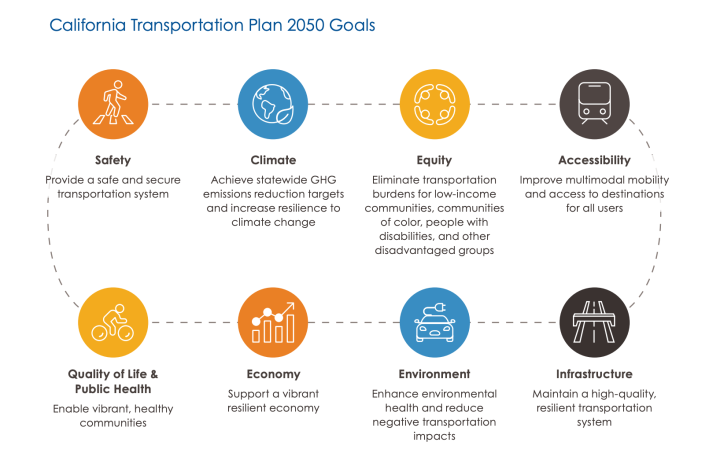“The climate crisis is upon us," said California State Transportation Agency Secretary David S. Kim when announcing the release of the Climate Action Plan for Transportation Infrastructure (CAPTI) the state's newest plan to mitigate and battle Climate Change. "...and transportation must be part of the solution immediately to stave off its worst effects.”
40 percent of all the state's Greenhouse Gas Emissions come from the transportation sector. CAPTI will guide transportation spending to bring that number down through encouraging alternatives to driving. CAPTI recognizes that technological improvements to automobiles and reduced emissions won't be enough to mitigate, much less reduce, the climate catastrophe that is already here.

A pair of executive orders from Governor Gavin Newsom called on the state to create and implement a plan to use $5.3 billion in annual discretionary transportation funding.Under CAPTI, where feasible and within existing funding program structures, the state will invest discretionary transportation funds in sustainable infrastructure projects that align with its climate, health and social equity goals. In other words, the state will prioritize those projects in funding decisions within existing programs.
Active Transportation Program (ATP) - To encourage increased use of active modes of transportation through investments in walking, biking, Safe Routes to Schools, and trail infrastructure projects and non-infrastructure programs.
Annual Funding Amount: $223 million
Interregional Transportation Improvement Program (ITIP) - To improve movement for people and goods across California on the State Highway System (SHS) and develop Intercity Passenger Rail corridors of strategic importance.
Annual Funding Amount: Variable (2022 ITIP anticipated to be $175 million)
Local Partnership Program (LPP) - To provide funding to local and regional agencies with voter approved fees/taxes dedicated solely to transportation improvements in order to improve aging infrastructure; road conditions; active transportation; transit and rail; or health and safety benefits.
Annual Funding Amount: $200 million
Solutions for Congested Corridors (SCCP) - To achieve a balanced set of transportation, environmental, and community access improvements within highly congested travel corridors throughout the state.
Annual Funding Amount: $250 million
State Highway Operations & Protection Program (SHOPP) - To preserve and protect the state highway system through improvements relative to the maintenance, safety, operation, and rehabilitation of state highways and bridges that do not add a new traffic lane to the system.
Annual Funding Amount: $4.2 billion
Trade Corridor Enhancement Program (TCEP) - To improve infrastructure on federally designated Trade Corridors of National and Regional Significance, on the Primary Freight Network, and along other corridors that have a high volume of freight movement.
Annual Funding Amount: $300 million
Transit & Intercity Rail Capital Program (TIRCP) - To fund transformative capital improvements that will modernize California’s intercity, commuter, and urban rail systems, and bus and ferry transit systems, to significantly reduce emissions of greenhouse gases, vehicle miles traveled, and congestion.
Annual Funding Amount: approximately $275 million
“From increased investments to support zero-emission transit, freight and rail as well as projects that vastly expand safe access to walking, biking and transit, we will develop a transportation system that is safer, more sustainable, more equitable and benefits all Californians – particularly those who have historically been left behind,” Kim continued.
CAPTI was developed through collaboration with many different state agencies along with extensive outreach and engagement with hundreds of stakeholders during the past 18 months. The California State Transportation Agency unveiled the draft plan on March 10 and updated the document based on feedback received during the ensuing 10-week public review period. A summary of the comments received and how they were addressed in the final plan is available here. You can also read previous Streetsblog coverage of the CTC and outreach process here.






